Pico Reefs are often overlooked in the reef keeping hobby which, at first glance, makes sense.
Why spend all the effort on such a small tank when you could buy a larger tank for only a little more money?
Well, there are situations where a Pico Tank is particularly useful, such as if you have a small office or living space. You might live somewhere where driving to an LFS for water is costly.
Finally, you may unknowingly be part of the group of hobbyists that love miniature aquascapes.
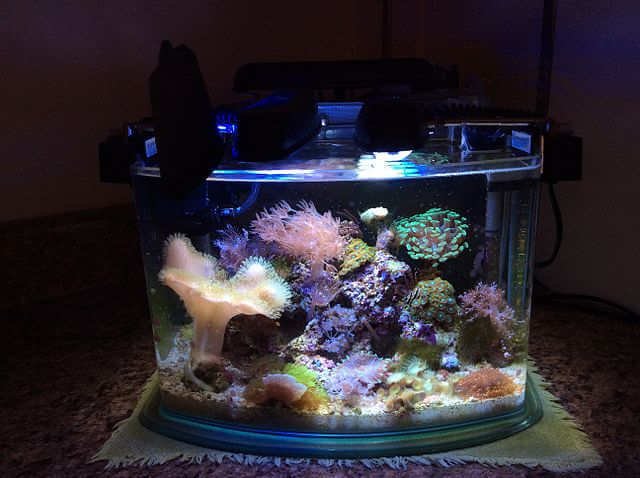
3 gallon pico reef tank (source)
But what really counts as a Pico Tank? The term “Pico” is an arbitrary term and the boundary on what counts as a Pico Tank is not well defined in the community.
Even so, it is generally accepted to be a tank with a volume of under 5 gallons (22 liters), with some sources saying 2.5 gallons or less.
Keeping a Pico Tank: benefits and downsides
Pico Reefs have their benefits, but you need to make sure that you know what you’re investing your time into.
Their environments are delicate, which is why many aquarists will tell you to start with a larger tank first. Large tanks have less fluctuations in water conditions, making them easier to maintain.
Pros:
- Pico Tanks contain more saltwater than larger tanks, which means that water changes are cheaper.
- They use less electricity, which is useful if you don’t want to add to your electricity bills.
- Due to its size, maintaining an aquascape is less difficult for when you want to clean spaces that would usually be difficult to get to in a larger tank.
Cons:
- Water changes need to be performed anywhere between once or twice a week, with a 100% change being most favorable.
- Corals will outgrow the tank with the lesser volume to grow in, and so more maintenance of the corals will be needed.
- The tank cannot support fish (apart from small invertebrates), otherwise it will not take the bio-load nor keep a happy fish.
- Water conditions can fluctuate very easily due it’s small volume.
- The price of the tank may exceed the price of buying a normal tank if you choose to use custom equipment.
Choosing the right tank
Originally, many Pico Reefs would be done in small Vases and glass containers. A heater and a small pump/air stone would be placed under the sand for filtration.
Much of this equipment might already be in your possession due to having previous tank builds, making this a good way to re-use unused equipment.
If you want a tank designed to hold smaller volumes of water, a newcomer in the world of Pico Reefing is the Minicompletetank. This tank is different as its volume is on the very low end for Pico Tanks at 0.2 gallons, while retaining most of the functionality of a larger tank.
Finally, there are also tanks in the larger range of 3-4 gallons, such as small desktop tanks, children’s tanks and the more expensive hobbyist’s tanks.
Pico Tank Types
Reef jars and containers
Pros:
- You can choose what shape and volume of water that you want the tank to have.
- Their price is low if you are re-using and buying little equipment.
- Candy jars, fishbowls and other glass containers are very common objects that are often easy to find at local stores.
Cons:
- Equipment may “jut out” and prevent all the volume in the tank from being used efficiently.
- Filtration options are sparse if you don’t want to use space that would otherwise be used for displaying corals. This causes some people to add a separate, smaller tank filled with plants for extra aeration and biological filtration.
Small consumer tanks
Pros:
- The tanks are usually already supplied with equipment designed to work well for the tank size, meaning that you don’t need to buy more equipment.
- The price is mid-range between that of a Minicompletetank and that of reef jars/containers.
Cons:
- Tanks may come with cheap and unreliable equipment.
- Many of these tanks are advertised to support the biological load of fish. For instance, the “fishbowl” is often believed to be large enough for a goldish. This is simply not true.
- The build quality of the tank is a hit or miss, depending on if you choose a common or less reliable brand.
The Minicompletetank
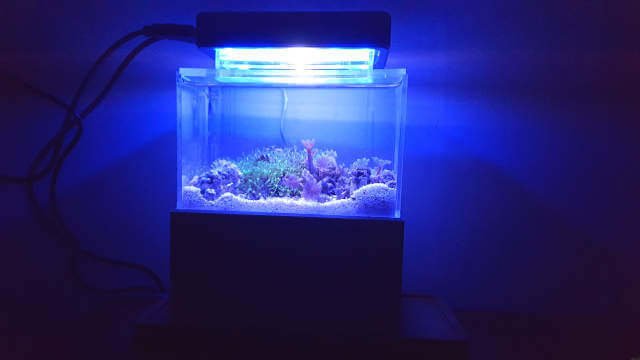
Source: my own picture
Pros:
- The tank hides its equipment very well inside the sump, which doubles as an area with half the tank’s volume that is ideal for biological filtration. It also doubles as a quick way to do water changes, due to the simplicity of removing the sump/stand.
- There is a growing community of people who are using this tank in their hobbies on the regular, meaning that it’s easy to get advice on how to keep these tanks.
- All the equipment needed, apart from the saltwater and corals themselves, are provided in kits bundled with the aquarium.
- The tank is powered entirely with one plug, connected to a dock that powers the rest of the equipment.
Cons:
- The aquarium is supplied in two main molded plastic parts which are sometimes hard to assemble due to how they are manufactured.
- The pump which circulates the water between the sump and main tank does not provide much flow. This usually results in people modifying the tanks which must be carried out with care.
- The tank’s price is higher than that of the jar and consumer tanks, ranging from $60-90
- The heater provided is not accurate - many people will include temperature regulators which will increase the price of the setup.
What also must be mentioned are tanks on the larger side of the spectrum at 4-5 gallons, such as the Fluval Evo, among others. These tanks tend to be expensive in comparison with prices over 100 dollars. Their benefit is their quality, which tends to be much higher given the more reliable reputation than with other brands.
In ranking of difficulty, most beginners to keeping Pico Reef tanks may want to stick to the Minicompletetank and hobbyist tanks. These provide most of the important equipment for you. For more experienced aquarists, reef jars and consumer tanks are also suitable.
Great corals for a Pico Tank
Not all corals are ideal for tanks of this size. Most will stick to soft corals since hard corals need brighter lighting. Some also need the occasional dosing of nutrients and very stable conditions. Soft corals are able to tolerate larger changes and higher concentrations of nitrates leaving more margin for error.
Another problem is flow. Many Pico Tanks do not have the space for water pumps. Corals such as clove polyps may build up detritus around the base of the coral, requiring more maintenance and care.
Below are five corals that are recommended if you start a Pico Tank.
1. Leather Toadstool Corals
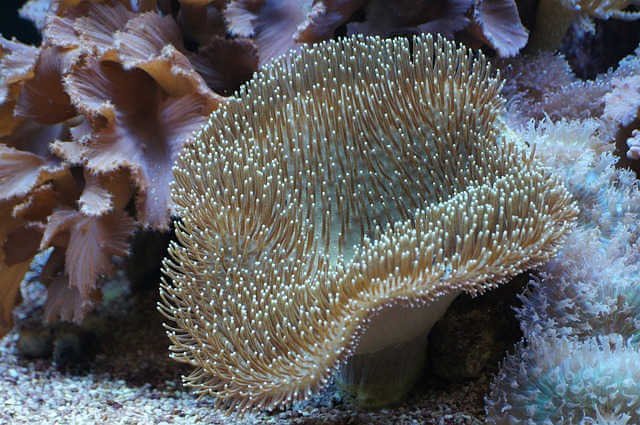
Mushroom Leather Coral (source)
This coral will need to be in at least moderate flow; but it is tolerant of water conditions and can adapt well to low light. Sometimes aquarists new to keeping this coral will notice an unusual skin covering the polyps. This is a natural part of the growth process for the coral and usually only lasts up to a week, where afterwards it will return to normal.
2. Pulsing Xenias
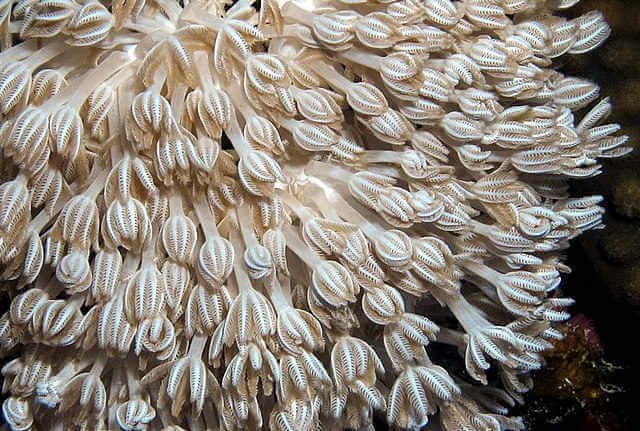
Xenia coral (source)
The pulsing of these corals keeps the tank looking very lively, which also plays a part producing light water flow. Despite this, they have a reputation for spreading fast in a tank and taking over the space available. This is controlled by trimming the corals and separating them from the main rock of the tank.
3. Mushroom Corals
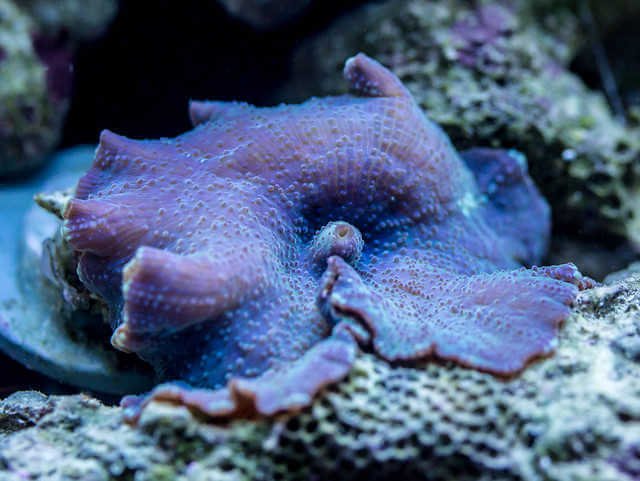
Blue Mushroom Coral (source)
Mushroom corals do not need bright lighting and are hardy for a tank of this size. They tend to reproduce quickly and will move slowly around the tank, so you must keep an eye on them in case they move into another coral’s domain.
4. GSP (Green Star Polyps)
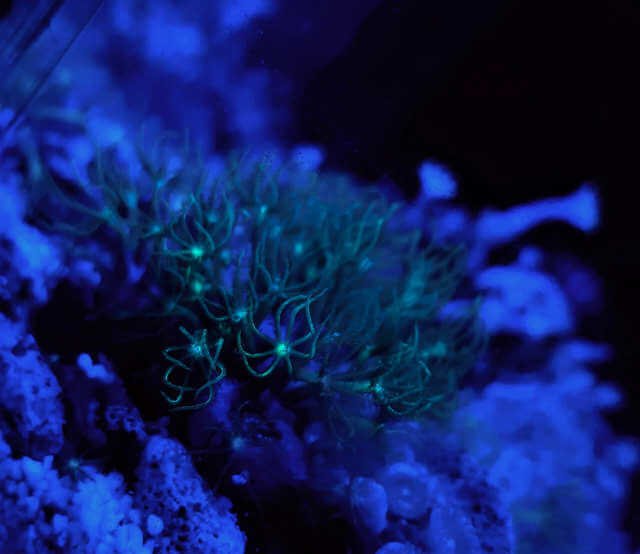
Source: my own picture
These corals are one of the hardiest. Do beware though, as they reproduce fast and will need cutting back once per several months in such a small tank.
5. Zoanthids
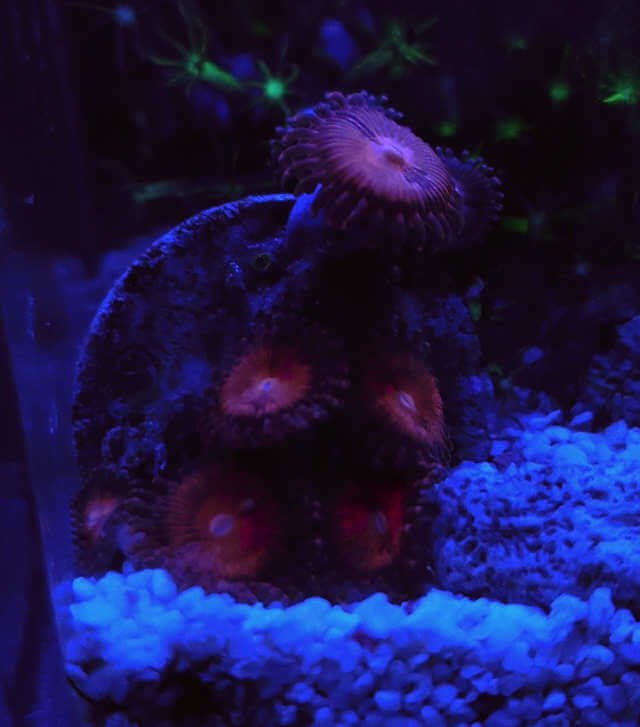
Source: my own picture
Zoanthids are a very common choice in reef tanks, and for a very good reason. These are hardy corals will grow fast and are tolerant to changes in conditions.
Lessons learned from a Pico reefer
There are 3 things that, from personal experience, have shown to be important to take into consideration to have a healthy tank.
- Test often, and do not over supplement or add an unnecessary source of nitrates. This will take a toll on your tank and corals will take a while to recover.
- If you add invertebrates, make sure they are small and reef friendly. Even a small snail may exhaust its food supply in a small environment. A small source of food may need to be supplemented, carefully, every now and then.
- Mistakes are part of the process. These tanks are a real challenge to maintain but will have amazing results if done right. Mistakes will happen and it is crucial to be able to learn from this with the combination of thorough research to maintain a healthy tank.
If you have any questions or comments, please ask below!

